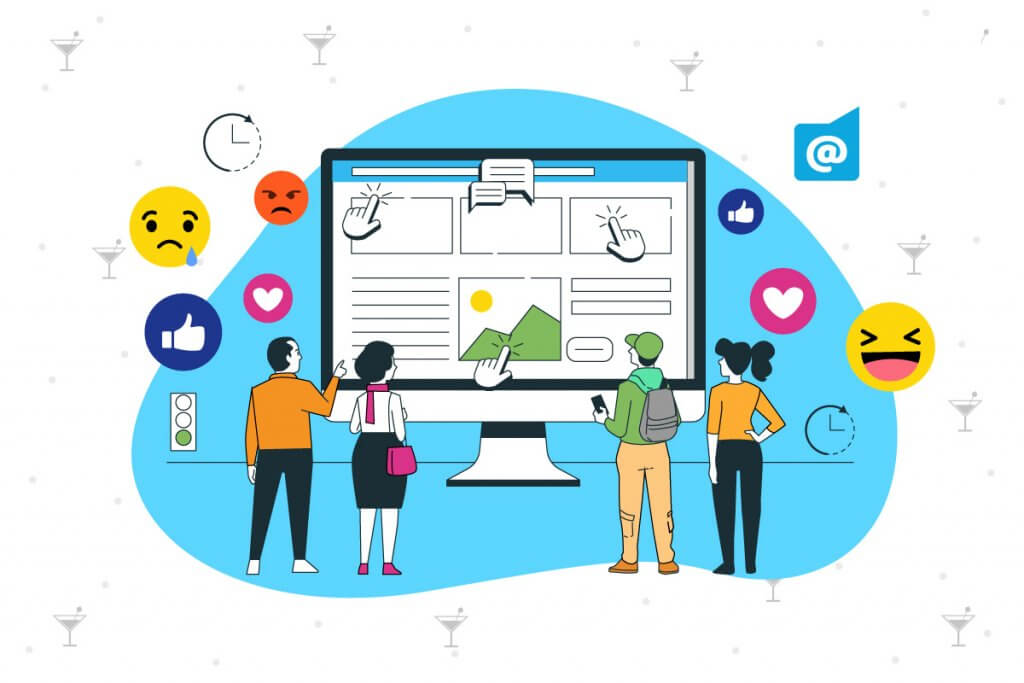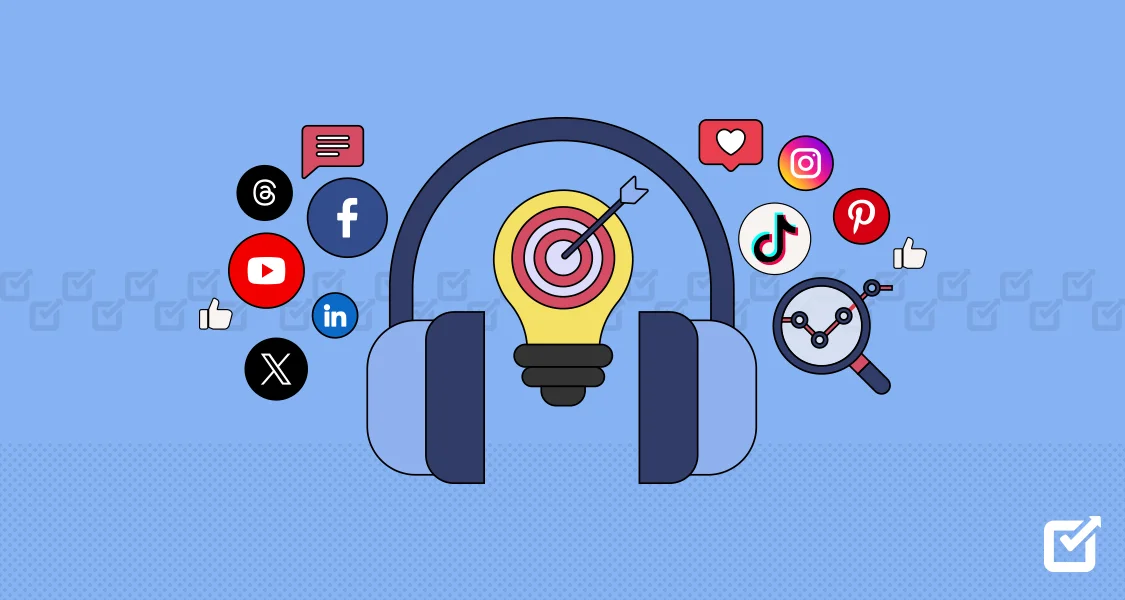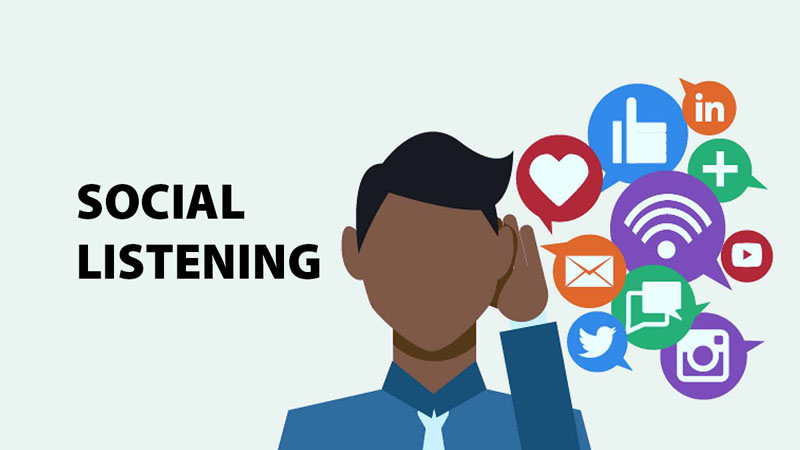In today’s digital landscape, customers are more vocal than ever before. They’re sharing their opinions, experiences, and desires across a vast network of social media platforms. This creates a goldmine of data for marketers, but only if they have the tools to listen. Social listening empowers businesses to tap into these conversations, gleaning invaluable insights into brand sentiment, competitor analysis, and emerging trends.
However, demonstrating the true impact of social listening can be challenging. That’s where statistics come in. By leveraging data-driven insights, you can build a compelling case for why social listening deserves a central role in your marketing strategy. Consider this: Locobuzz found that close to 61% of businesses have implemented social listening systems to monitor keyword mentions. This widespread adoption highlights how integral social listening has become for brands seeking to stay ahead of the curve by understanding and engaging with their audience in real-time. This statistic not only validate the effectiveness of social listening but also emphasize its necessity in modern marketing efforts.
What is Social Listening

Source: Aim Technologies
Social listening goes beyond simply monitoring brand mentions on social media. It’s the process of actively collecting, analyzing, and interpreting these conversations to gain valuable customer insights. Social listening allows you to understand what people are saying about your brand, your competitors, and your industry as a whole. This empowers you to make data-driven decisions about your marketing strategy.
In contrast, social media monitoring is a more observational approach. It involves tracking mentions of your brand or specific keywords across social media platforms. While social media monitoring is a valuable tool for gathering data, social listening extends beyond this by providing deeper insights into customer sentiments and trends, helping to better understand the broader context of the conversations.
5 Social Listening Statistics for 2024
Source: ResearchGate
While social listening isn’t a new concept, its importance in today’s marketing landscape is undeniable. Here are five key statistics that highlight the power of social listening in 2024:
Statistic #1: 80% of all tweets about customer service are negative (Finances Online, 2024): This statistic underscores the importance of social listening for identifying customer service issues. By proactively monitoring social conversations, businesses can address negative sentiment before it escalates and damages brand reputation.
Statistic #2: 61% of businesses today employ social listening, with over 82% of marketers viewing it as a crucial planning component (Sprinklr, 2023): This widespread adoption signifies the growing recognition of social listening’s value. Marketers are increasingly turning to social listening to gain insights and inform their strategies.
Statistic #3: A 2023 study by McKinsey found that companies that excel at social listening experience customer satisfaction rates that are 17% higher than competitors: This statistic demonstrates the direct link between social listening and customer satisfaction. By understanding customer needs and grievances, businesses can tailor their approach to improve satisfaction.
Statistic #4: Social listening can improve campaign ROI by up to 25% by enabling data-driven targeting and content creation (Socialbakers, 2024): This statistic emphasizes the financial benefits of social listening. By using insights to target the right audience and craft relevant content, businesses can maximize the return on their marketing investments.
Statistic #5: Social listening practitioners are looking beyond social media for insights. Almost 75% say review sites and forums are important, and around 70% say Reddit is important. By incorporating multiple sources, companies can gain a more holistic understanding of customer sentiments and preferences, leading to more informed decision-making and improved customer experiences (The Social Intelligence Lab, 2022).
5 Social Listening Statistics for Social Media Usage
Statistic #1: Over 5 billion people worldwide are using social media, marking a 5.6% increase from the previous year (Source: DataReportal, 2024). This explosive growth signifies a vast and ever-expanding audience for businesses. Social listening empowers you to tap into this potential customer base and tailor your strategies for maximum reach and impact.
Statistic #2: On average, users spend 2 hours and 31 minutes per day on social media platforms (Source: Global Web Index, 2024). This significant daily engagement highlights the necessity for businesses to actively participate in these conversations. Social listening allows you to monitor these interactions, engage with your audience, and build stronger brand loyalty.
Statistic #3: The average user visits 7.2 social media platforms each month, indicating the need for social listening tools to monitor diverse channels effectively and capture comprehensive consumer insights across various platforms (Source: Hootsuite, 2024).
Statistic #4: Social media isn’t a niche platform! With a roughly 266 million new users on social media between October 2023 -2024, it’s a critical way for businesses to connect with their audience. Social listening helps you understand what people are saying about your brand and industry, so you can tailor your message and connect with this massive audience (Source: SocialPilot, 2024).
Statistic #5: North American social media users grew by 6% despite being a mature market (Source: eMarketer, 2024). This ongoing growth signifies a dynamic landscape with evolving trends. Social listening allows you to stay ahead of the curve, identify new opportunities, and adapt your strategies for continued success in this ever-changing environment.
3 Social Listening Statistics on Customer Sentiment Analysis
Understanding customer sentiment is no longer a competitive advantage, it’s a business imperative. Customers are sharing their opinions and experiences more than ever before, across a vast network of social media platforms. Social listening empowers you to tap into this goldmine of data, gleaning invaluable insights that can shape your marketing strategies and cultivate positive customer experiences. Here are three key statistics that demonstrate the power of social listening for customer sentiment analysis:
Statistic #1: 96% of dissatisfied customers never complain directly to a business, but vent their frustrations on social media (Source: LocaBuzz, 2024). This highlights the power of social listening in uncovering hidden customer dissatisfaction.
Statistic #2: Businesses that respond to negative social media comments within an hour see a 70% increase in customer satisfaction (Source: Socialbakers, 2024). Social listening allows you to identify negative comments quickly, enabling you to address them promptly and demonstrate your commitment to customer satisfaction.
Statistic #3: Companies that excel at social listening experience a 17% higher customer satisfaction rate compared to competitors (Source: McKinsey & Company, 2023). This statistic underlines the direct link between social listening and positive customer experiences.
2 Social Listening Statistics for Brand Reputation Management
In today’s digital age, brand reputation is more fragile than ever. A single negative comment can spread like wildfire across social media, potentially damaging your customer relationships and bottom line. However, there’s a powerful tool at your disposal: social listening. By actively monitoring online conversations, you can identify potential issues early on and take steps to protect your brand reputation. Here are two key statistics that illustrate the impact of social listening on brand reputation management:
Statistic #1: Social listening allows for real-time identification of brand mentions, enabling businesses to proactively address negative sentiment and potential crises before they damage brand reputation (Source: Meltwater, 2024). This proactive approach safeguards brand reputation by addressing issues early on.
Statistic #2: Social listening can improve brand perception by 20% through targeted social media campaigns informed by customer insights (Source: We Are Social, 2024). This statistic highlights the positive impact of social listening on brand perception. By understanding customer preferences and sentiment, businesses can craft targeted social media campaigns that resonate with their audience, leading to a more positive brand image.
2 Social Listening Statistics for Trend Identification
Social media has become a powerful trend incubator, where new ideas and preferences bubble up and gain momentum. But how can you, as a business, tap into this ever-evolving conversation and identify trends before they become mainstream? Social listening provides the answer. Here are two key statistics that demonstrate the power of social listening for trend identification:
Statistic #1: Social listening can identify emerging trends up to 3 times faster than traditional methods, allowing businesses to capitalize on new opportunities before competitors (Source: Semrush, 2024). This highlights the agility advantage social listening offers by enabling businesses to spot trends early and adapt their strategies accordingly.
Statistic #2: Companies that actively monitor social media conversations for trends experience a 10% increase in revenue growth compared to those who don’t (Source: Socialbakers, 2024). This statistic showcases the tangible financial benefits of leveraging social listening to stay ahead of trends and adapt to evolving customer preferences.
2 Social Listening Statistics for Competitive Analysis
In the ever-competitive world of business, understanding your competition is key to staying ahead. Social listening goes beyond just monitoring your own brand mentions. It’s a powerful tool for gaining valuable insights into your competitors’ strategies and customer sentiment. Here are two key statistics that demonstrate the power of social listening for competitive analysis:
Statistic #1: 82% of social media conversations happen without brand mentions. This means valuable customer insights and industry trends can be unearthed through social listening, even if your competitors aren’t directly mentioned (Source: DataReportal, 2023)
Statistic #2: According to a 2022 study by Oktopost, 45% of marketers use social listening to track brand mentions compared to their competitors. This highlights the growing importance of using social listening for competitive benchmarking.
2 Actionable Social Listening Statistics for Marketers
Social listening isn’t just about eavesdropping; it’s about taking action! Here are two statistics that showcase the power of social listening for driving impactful marketing strategies:
Statistic #1: 78% of consumers expect brands to respond to social media messages. By using social listening tools and setting response protocols, you can identify and address messages promptly, building brand loyalty through exceptional customer service (Source: Salesforce, 2022).
Statistic #2: Brands that respond to customer complaints on social media see a 25% increase in customer satisfaction. By using social listening to track negative brand sentiment, you can address concerns quickly and prevent issues from escalating (Source: Socialbakers, 2023).
3 Future Trends in Social Listening
The social listening landscape is constantly evolving, with new technologies and approaches emerging to help brands gain deeper customer insights. Here are 3 key trends to watch in 2024:
Trend #1: AI and Machine Learning Advancements: Social listening is becoming increasingly sophisticated thanks to advancements in Artificial Intelligence (AI) and Machine Learning (ML). These technologies can automate data collection and analysis, allowing for real-time sentiment tracking, identification of emerging topics, and even the ability to predict future trends.
Trend #2: Integration with Marketing Technologies: The future of social listening lies in its seamless integration with other marketing tools. Imagine a world where social listening data informs your content marketing strategy, influences your customer relationship management (CRM) efforts, and even fuels your targeted advertising campaigns. This interconnected approach will create a holistic view of your audience and drive more impactful marketing initiatives.
Trend #3: The Rise of Visual and Video Content: Social media is increasingly dominated by visual content like images and videos. Social listening tools are adapting to analyze these formats effectively, allowing brands to understand audience sentiment around visual content and identify trends in user-generated content. This empowers brands to tailor their visual marketing strategies and leverage user-created content for greater reach and engagement.
Understand How Social Listening Tools Work
Social listening tools are your secret weapon for understanding the online conversation around your brand, industry, and competitors. But how exactly do these platforms work their magic? Let’s delve into their functionality and key features:
- Data Gathering Powerhouse: Social listening tools act as tireless data collectors, scouring the vast expanse of the internet. They can pull data from various sources, including social media platforms (Twitter, Facebook, Instagram, etc.), online forums, review sites, and even blogs.
- Keyword Wizardry: You define the keywords and phrases you want to track. This could be your brand name, competitor names, industry terms, or even specific product mentions. The tool then sifts through the collected data, identifying relevant conversations based on your chosen keywords.
- Sentiment Analysis – Unmasking Emotions: Social listening tools go beyond just finding mentions. They employ sentiment analysis to understand the emotional tone behind the conversations. This allows you to see if people are expressing positive, negative, or neutral opinions about your brand or industry topics.
- Trend Tracking – Spotting What’s Hot: These platforms are adept at identifying emerging trends and topics gaining traction online. This empowers you to stay ahead of the curve and tailor your marketing strategies to capitalize on current interests.
- Real-Time Alerts – Never Miss a Beat: Imagine getting notified the moment someone mentions your brand on social media. Social listening tools offer real-time alerts, keeping you informed about critical conversations as they unfold. This allows you to respond promptly to customer inquiries, address concerns, and participate in relevant discussions.
Beyond the Basics: Many social listening platforms offer additional functionalities like:
- Influencer Identification: Discover key influencers talking about your brand or industry.
- Brand Advocacy Tracking: Monitor brand mentions by loyal customers and brand advocates.
- Competitive Benchmarking: Compare your brand sentiment and performance to your competitors.
By harnessing the power of social listening tools, you gain a deeper understanding of your audience, identify emerging trends, and make data-driven decisions to optimize your marketing strategies.
3 Βest Social Listening tools for your brand
- Social Listening Platforms: Social listening platforms offer a powerful way to understand the online conversation surrounding your brand, industry, and competitors. Palowise offers a comprehensive suite of social listening features, with a specialization in the Greek language and the South-Eastern European business ecosystem. It’s a great option for brands targeting this region or those seeking a platform with strong language capabilities.
-
Online Forums and Communities: Industry-specific online forums and communities are a treasure trove of insights. Participate in discussions, ask questions, and observe how others talk about your brand or industry. This offers valuable perspectives on customer needs and pain points, allowing you to tailor your marketing strategies accordingly.
- Social Media Listening Features: Many popular social media platforms like Twitter and Facebook offer built-in listening features. Utilize these tools to track brand mentions, analyze sentiment, and identify trending topics within your industry directly on the platform.
3 Best Practices for Implementing Social Listening

Source: SocialChamp
Social listening can be a game-changer for understanding your audience and refining your marketing strategies. But to truly harness its power, implementing the right practices is key. Here are some actionable tips to get you started:
#1: Set Clear Objectives
Before diving in, define your social listening goals. Are you aiming to improve brand sentiment, identify customer pain points, or track competitor strategies? Having clear objectives ensures you focus on collecting and analyzing the most relevant data.
#2: Choose the Right Tools
Social listening platforms vary. Consider your budget, target audience, and desired features like sentiment analysis, influencer identification, and competitor benchmarking. Explore options like Palowise with these features.
#3: Regularly Review and Adjust Strategies
Social listening is an ongoing process. Regularly review your data to identify trends, adjust your strategies based on insights, and refine your approach over time. Remember, social media is dynamic, so staying flexible is crucial.
2 Case Studies: Brands Leveraging Social Listening Statistics

Source: EvolveDash
Case Study #1: McDonald’s – Addressing Changing Customer Preferences
- The Challenge: McDonald’s noticed a decline in customer satisfaction through social listening statistics. Negative online conversations pointed towards a growing desire for healthier menu options.
- Solution: Leveraging this data, McDonald’s introduced a new line of salads and healthier options, addressing customer concerns and improving brand sentiment.
Case Study # #2: GoPro – Identifying Untapped Influencer Marketing Opportunities
- The Challenge: GoPro wanted to expand its reach beyond extreme sports enthusiasts. Social listening statistics revealed a growing interest in travel vlogging using GoPro cameras.
- Solution: By identifying travel vloggers through social listening, GoPro partnered with relevant influencers, reaching a new audience and boosting brand awareness.
These examples illustrate the power of social listening statistics in informing data-driven marketing decisions and fostering stronger customer relationship.
Make Data-Driven Decisions with Palowise’s Social Listening Platform
In today’s digital age, understanding online conversations is crucial for any successful marketing strategy. Social listening statistics provide invaluable insights into customer sentiment, competitor analysis, and emerging trends. We explored case studies showcasing how brands leveraged these statistics to address customer concerns, identify influencer opportunities, and ultimately achieve success.
Palowise stands out as a powerful social listening platform, offering features like sentiment analysis, competitor benchmarking, and influencer identification. User reviews consistently highlight Palowise’s data accuracy and its effectiveness in driving brand awareness.
Ready to harness the power of social listening and make data-driven marketing decisions? Request a demo from Palowise today and see how their platform can empower your brand strategy.


